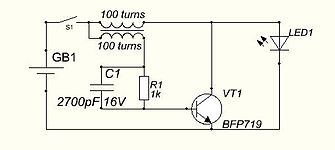Dao động nghẹt


Mạch tạo dao động nghẹt là mạch dao động điện tử đơn giản lập bằng một phần tử tích cực như transistor và một biến áp thích hợp, cùng các phần tử RC phụ trợ, tạo ra xung sóng liên tục có hệ số độ sâu xung (duty cycle) rất cao, và tạo ra xung điện áp có thể cao hơn mức điện áp nguồn nhiều lần.[1]
Tên gọi nghẹt bắt nguồn từ thực tế là phần tử khuếch đại bị cắt hoặc "bị chặn" trong hầu hết chu kỳ hoạt động. Tín hiệu ra không có dạng sin, và được dùng làm bộ tạo thời kế (timer) và cho ứng dụng tạo điện áp đủ cao công suất nhỏ từ các nguồn điện áp thấp.[2]
-
Mạch Joule thief để cấp năng lượng cho một LED phát sáng từ pin 1,5 V
-
Dạng sóng của dao động nghẹt Joule thief, đỉnh dương bị cắt bởi LED
Mạch dao động nghẹt hiện được ứng dụng:
- Đổi điện DC-DC với tỷ số nâng áp có thể đến trên 100 lần, như điện áp 1200 V từ nguồn 12 V trong máy đo đạc phân tích di động, thắp đèn dây huỳnh quang (Elwire hay Electro-luminescent wire), trong vợt diệt muỗi, bắt cá,...
- Đổi điện DC-DC với tỷ số vừa phải để thắp sáng đèn LED.
- Các ứng dụng khác: Nếu tín hiệu ra được sử dụng làm tín hiệu âm thanh, các âm đơn giản cũng đủ cho các ứng dụng như báo thức hoặc thiết bị thực hành mã Morse. Một số máy ảnh sử dụng mạch tạo dao động nghẹt để nhấp nháy đèn flash trước khi chụp nhằm giảm hiệu ứng mắt đỏ.
Tham khảo
[sửa | sửa mã nguồn]- ^ Jacob Millman and Herbert Taub, 1965, Pulse, Digital, and switching Waveforms: Devices and circuits for their generation and processing, McGraw-Hill Book Company, NY, LCCCN 64-66293. See Chapter 16 "Blocking-Oscillator Circuits" pages 597-621 and problem-pages 924-929. Millman and Taub observe that "As a matter of fact, the only essential difference between the tuned oscillator and the blocking oscillator is in the tightness of coupling between the transformer windings." (p. 616)
- ^ Handbuch für Hochfrequenz- und Elektro-Techniker. Band V. Verlag für Radio-Foto-Kinotechnik, Berlin-Borsigwalde 1970 (Fachwörterbuch mit Definitionen und Abbildungen).
- Tài liệu
- Joseph Petit and Malcolm McWhorter, 1970, Electronic Switching, Timing, and Pulse Circuits: 2nd Edition, McGraw-Hill Book Company, NY, LCCCN: 78-114292. See Chapter 7 "Circuits Containing Inductors or Transformers" pages 180-218 in particular chapters 7-13 "The monostable blocking oscillator" p. 203ff and 7-14 "The astable blocking oscillator" p. 206ff.
- Jacob Millman and Christos Halkias, 1967, Electronic Devices and Circuits, McGraw-Hill Book Company, NY, ISBN 0-07-042380-6. For a tuned version of the blocking oscillator, i.e. a circuit that will make pretty sinewaves if properly designed, see 17-17 "Resonant-Circuit Oscillators" pp. 530–532.
- F. Langford-Smith, 1953, Radiotron Designer's Handbook, Fourth Edition, Wireless Press (Wireless Valve Company Pty., Sydney, Australia) together with Radio Corporation of America, Electron Tube Division, Harrison NJ (1957).
Wikimedia Commons có thêm hình ảnh và phương tiện truyền tải về Dao động nghẹt.
Liên kết ngoài
[sửa | sửa mã nguồn]- The blocking oscillator, web page by James B. Calvert. An elementary (no mathematics) and informative description of various blocking oscillator circuits, employing BJTs and Triodes.
- Circuit models to predict switching performance of nanosecond blocking oscillators, J. McDonald, IEEE Transactions on Circuits and Systems, 1964, Volume 11, Issue 4, 442- 448. A paper deriving some circuit models in order to predict the switching performance of BJT blocking oscillators.
Chúng tôi bán
 GIẢM
18%
GIẢM
18%
135.000 ₫
165.000 ₫
 GIẢM
24%
GIẢM
24%
19.000 ₫
25.000 ₫
 GIẢM
15%
GIẢM
15%
102.500 ₫
120.000 ₫


![[Tóm tắt và đánh giá] Bạn không thông minh lắm đâu | Cuốn sách tâm lý học thú vị bạn nên đọc vào năm 2024](https://down-bs-vn.img.susercontent.com/vn-11134201-23030-c1d4ivny4kov19.webp)




:no_upscale()/cdn.vox-cdn.com/uploads/chorus_asset/file/24873961/vlcsnap_2023_08_25_14h40m29s345.jpg)
